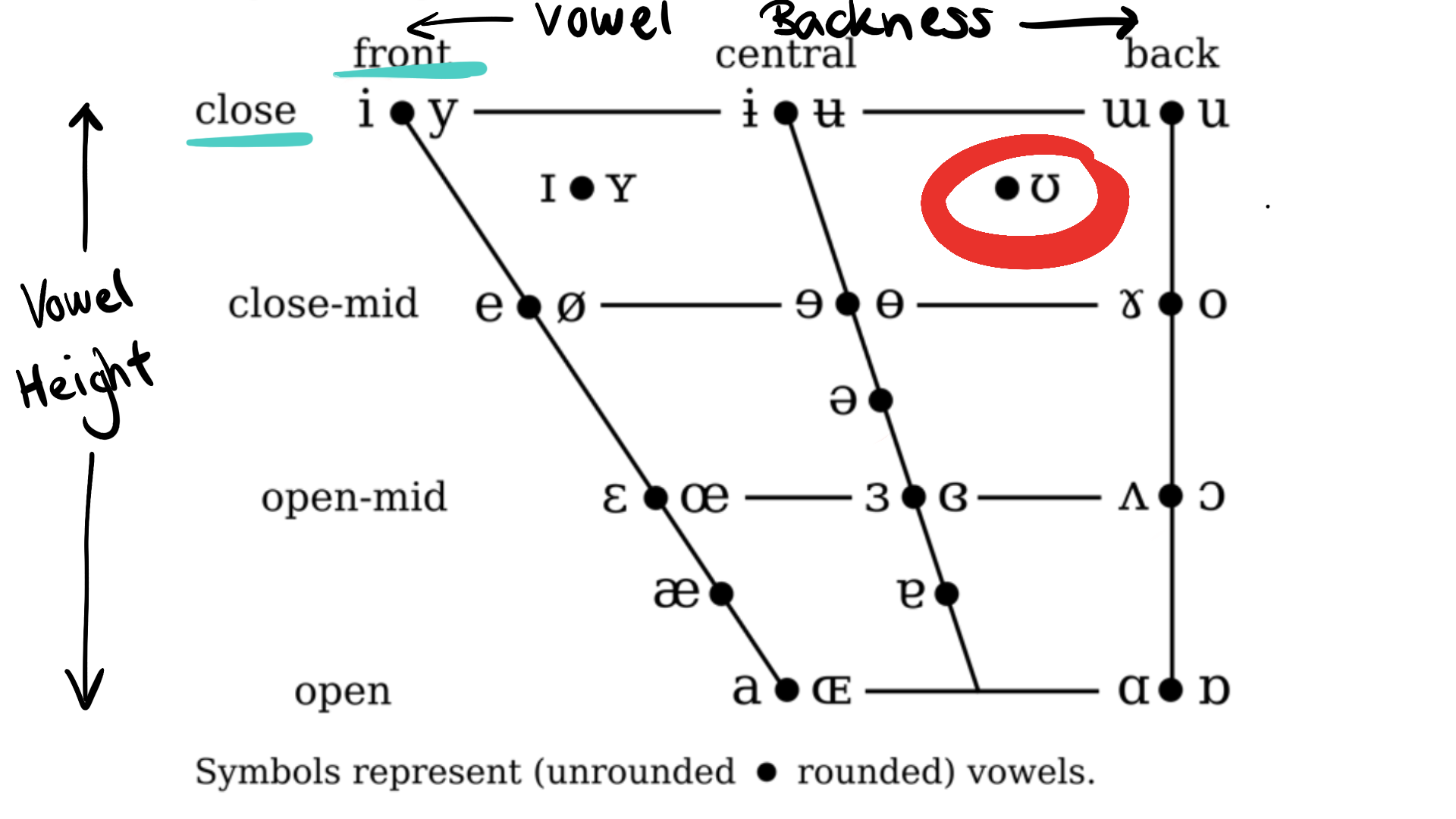The UH-Sound (part 3)
We’re talking about the UH-sound now. Now I get it, ANOTHER F*@%K#ING UH-sound. You can’t have 3 UH’s.
Well, unfortunately I am serious.
The issue being that in isolation, the [ʊ] sound still is most closely reflected as an UH.
Think of the word - PULL. The sound represented by the letter U is still an UH-sound.
It’s simply a different UH sound than the sound in THE and the sound in CUT.
We’ll talk more about the sound distinction though.
This near-close near-back rounded vowel, or near-high near-back rounded vowel is represented by the letter ‘u’ with wings - like a horseshoe.
It’s called an upsilon.
The International Phonetic Alphabet (IPA) symbol for this sound is /ʊ/. Its sound symbol is a more circular ‘u’ with wings.
In General American English and Canadian English, the [ʊ] sound is the sound in the word ‘BOOK’ or ‘HOOK’.
SYMBOL
On the IPA vowel chart, it is located on the top right of the chart.
The Color Vowel® Chart, created by Karen Taylor and Shirley Thompson in 1999, is another visual organizer for spoken English and represents how to learn and think about vowels. It refers to this sound as the ‘WOODEN HOOK’ sound or the WOODEN vowel. Notice the consistent placement on the mid-right corner of each respective chart.
The Color Vowel® Chart, 5th Edition © 2019. ColorVowel.com. Used with Creative Commons licensing (CC BY-NC-ND).
SOUND
So, the UH-sound in PULL is more similar to the OO-sound in POOL than you think. So if you have the OO-sound, we’ll start from there.
The OO-sound is a tense sound. Your lips are tensed. Your tongue is tensed.
For the UH-sound, your tongue is relaxed, which alters the tongue shape and position. The tongue is slightly lower and not as high or back in the mouth.
When learning, some English language learners are taught that the OO-sound is long and the UH-sound is short but the more accurate difference is the tenseness of the tongue. You need to learn to relax the tongue to modify the tongue position.
Pretend that the tongue is numb from having had an local numbing shot at the dentist office. Same goes for the lips. Whereas the OO-sound has lip engagement for rounding, the UH-sound has less tension and a more relaxed neutral lip shape.
Now, comparing the UH-sound in PULL to the UH-sound in CUT, in CUT, the vowel is produced closer to the centre of the mouth over the back part of the tongue. It is a open-mid back unrounded vowel. The UH-sound in PULL is a near-close near back rounded vowel. So it is in fact produced closer to the back of the mouth with the jaw less open and protruded roundedness meaning the lips are drawn together somewhat.
Now, comparing the UH-sound in PULL to the UH-sound in THE, in THE, the vowel is again produced closer to the centre of the mouth over the central part of the tongue. It is a mid central vowel. The UH-sound in PULL is a near-close near back rounded vowel. So again, produced closer to the back of the mouth with a more closed mouth shape.
The tongue lifts in the back, towards the soft palate, for this vowel. The tongue tip pulls slightly back so it’s not quite touching the back of the bottom front teeth. The lips aren’t completely relaxed: the corners of the mouth come in a little so the lips flare and push away from the face
FEATURES
The [ʊ] sound features are as follows.
Its vowel height is near-close, also known as near-high, which means the tongue is not quite so constricted as a close vowel (high vowel).
Its vowel backness is back, which means the tongue is positioned back in the mouth without creating a constriction that would be classified as a consonant.
Its roundedness is protruded, which means that the corners of the lips are drawn together, and the inner surfaces exposed. The prototypical [ʊ] has a weak protruded rounding, more like [ɔ] than the neighboring cardinal vowels.
VISUAL REPRESENTATION
In English, the [ʊ] sound is reflected in spelling in many different ways. Depending on the specific English dialect, it may be written using any of the following letters:
oo - hook, book, took, look, rook, shook, foot, cook, good, stood, wood, wool, crook, looking, childhood,
u - full, pull, push, bull, bullet, bush, cushion, full, pudding, put, sugar
o - into (reduced form), onto (reduced form), bosom, wolf, woman
ou - could, would, should
The /ʊ/-sound never occurs in word-initial position, and rarely in final position. It mainly occurs in the middle of words.
The reason why I’m especially showing you the different spelling combinations that can create this sound is that there will ALWAYS be exceptions, weird spellings, or other things that impact how reliable the written representation will be.
LISTENING
You need to be able to identify the sound; rhyming is an excellent way to match it properly. So, if you are not good already, start practicing rhyming and hearing the sound.
| OO-Sound | UH-Sound |
|---|---|
| pool | pull |
| toque | took |
| stewed | stood |
| wooed | would/wood |
| Luke |
look |
| suit | soot |
I’m breaking down every single sound down for you so that you can learn how to produce each sound in English accurately. Sometimes, we’ll have easier sounds and sometimes we’ll have harder sounds.
If you’ve grasped this sound, then great! But if you’ve got a tip that might work for others, or you took a while to produce this sound correct but something clicked for you, let me know down below in the comments. My goal is to have a community know what to do when they’re stuck!



